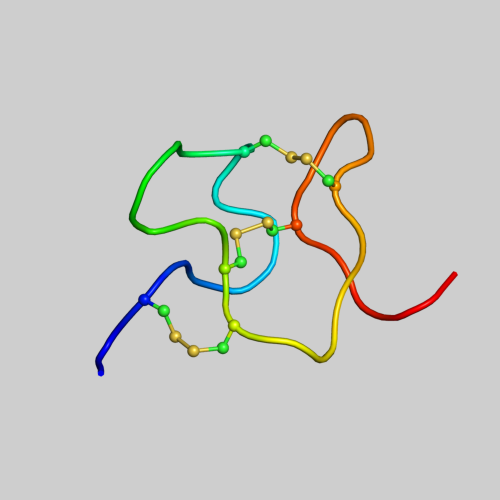Heteropodatoxin on:
[Wikipedia]
[Google]
[Amazon]
 Heteropodatoxins are
Heteropodatoxins are
 Heteropodatoxins are
Heteropodatoxins are peptide
Peptides are short chains of amino acids linked by peptide bonds. A polypeptide is a longer, continuous, unbranched peptide chain. Polypeptides that have a molecular mass of 10,000 Da or more are called proteins. Chains of fewer than twenty am ...
toxins from the venom of the giant crab spider ''Heteropoda venatoria
''Heteropoda venatoria'' is a species of spider in the family Sparassidae, the huntsman spiders. It is native to the tropical regions of the world, and it is present in some subtropical areas as an introduced species. Its common names include gi ...
'', which block Kv4.2 voltage-gated potassium channel
Voltage-gated potassium channels (VGKCs) are potassium channel, transmembrane channels specific for potassium and Voltage-gated ion channel, sensitive to voltage changes in the cell's membrane potential. During action potentials, they play a ...
s.
Sources
Heteropodatoxins are purified from the venom of the giant crab spider, ''Heteropoda venatoria''.Chemistry
Heteropodatoxins contain anInhibitor Cystine Knot
An inhibitor cystine knot (also known as ICK or Knottin) is a protein structural motif containing three disulfide bridges. Knottins are one of three folds in the cystine knot motif; the other closely related knots are the growth factor cystine kn ...
(ICK) motif, which consist of a compact disulfide-bonded core, from which four loops emerge. There are three different heteropodatoxins:
* heteropodatoxin-1, also known as Toxin AU3/KJ5 or HpTx1
* heteropodatoxin-2, also known as Toxin KJ6 or HpTx2
* heteropodatoxin-3, also known as Toxin AU5C/KJ7 or HpTx3
These three toxins
A toxin is a naturally occurring poison produced by metabolic activities of living cells or organisms. They occur especially as proteins, often conjugated. The term was first used by organic chemist Ludwig Brieger (1849–1919), derived ...
are structurally similar peptides of 29-32 amino acids. They show sequence similarity to Hanatoxins, which can be isolated from the venom of the Chilean rose tarantula
The Chilean rose tarantula (''Grammostola rosea''), also known as the rose hair tarantula, the Chilean fire tarantula, or the Chilean red-haired tarantula (depending on the color morph), is probably the most common species of tarantula available ...
Grammostola rosea.
Target
Heteropodatoxins block A-type, transientvoltage-gated potassium channel
Voltage-gated potassium channels (VGKCs) are potassium channel, transmembrane channels specific for potassium and Voltage-gated ion channel, sensitive to voltage changes in the cell's membrane potential. During action potentials, they play a ...
s. All three toxins have been shown to block the potassium channel Kv4.2. Recombinant heteropodatoxin-2 blocks the potassium channels Kv4.1, Kv4.2 and Kv4.3, but not Kv1.4, Kv2.1, or Kv3.4.
Mode of action
Heterpodatoxin-2 most likely acts as a gating modifier of the Kv4.2 channels. It shifts the voltage dependence of theactivation
In chemistry and biology, activation is the process whereby something is prepared or excited for a subsequent reaction.
Chemistry
In chemistry, "activation" refers to the reversible transition of a molecule into a nearly identical chemical or ...
and the inactivation of the Kv4.3 potassium channel
Potassium channels are the most widely distributed type of ion channel found in virtually all organisms. They form potassium-selective pores that span cell membranes. Potassium channels are found in most cell types and control a wide variety of ...
to more positive values. As a result, in the presence of the toxin this channel has a higher probability of being inactivated and a larger depolarization is needed to open the channel. However, heterpodatoxin-2 did not affect the voltage dependence of the Kv4.1 channel, suggesting that the precise mechanism of block remains to be elucidated, and a role as a pore blocker cannot be excluded. The voltage dependence of Kv4.2 block varies among the three different heteropodatoxins. It is less voltage dependent for HpTx1 than for HpTx2 or HpTx3.
Toxicity
The giant crab spider can cause a locally painful bite.References
Bibliography
* * *{{cite journal , vauthors=Zarayskiy VV, Balasubramanian G, Bondarenko VE, Morales MJ , title=Heteropoda toxin 2 is a gating modifier toxin specific for voltage-gated K+ channels of the Kv4 family , journal=Toxicon , volume=45 , issue=4 , pages=431–42 , year=2005 , pmid=15733564 , doi=10.1016/j.toxicon.2004.11.015 Ion channel toxins